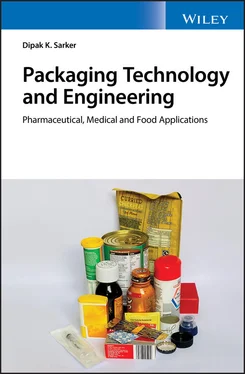1 ...6 7 8 10 11 12 ...18 Table 1.1 Packaging: contains, protects, preserves, transports, ‘informs’, and ‘sells’.
| Types of use/function |
Risk |
Example |
| Primary: protects and directly envelops the drug (pharmacy shelf or home) |
Could compromise and contaminate the product |
Can, pouch, blister, jar, bottle, or ampoule |
| Secondary: protects the packaging that protects the drug (for warehousing); used to group primary packages together |
Misleading information on the pack |
Carton or box |
| Tertiary: protects the secondary packaging. Purpose: bulk handling, warehouse storage, and transport shipping. The most common form is a palletised unit load that packs tightly into shipping/haulage containers |
|
Pallet, hopper, skip, or over‐wrap |
The international identity code ( Table 1.2) ascribed to the recycling of materials used was devised in combination by the bodies concerned with packaging use but fell under the remit of the American Society for the Testing of Materials (ASTM), which encompasses the International Resin Identification Code (RIC); the American National Standards Institute; and the European Commission (based on decision 97/127/EC – ID System for Packaging Materials, which is underpinned by council directive 94/62/EC). These bodies and nomenclature systems together have helped group materials into six usable categories ( Table 1.2). The categories of plastics, paper, metals, glass, and the seldom used category ‘organic materials’ in addition to composite materials are now marked on most products to aid recycling and clarify chemical make‐up. The codes range from 01 for PET plastic, 22 for paper, 41 for aluminium, and 79 for glass through to 80 and higher numbers for composite or mixed materials. The table also indicates the main uses of the listed material, which includes, for example, in the case of iron (number 40), its use in aerosol cans, tin‐plated cans, lids, and staples but that might also include fittings and hinges in wooden crates. Indexed labelling of packaging materials in this manner has been hugely valuable and is responsible for much of the improvement in worldwide recycling and local municipality recycling practice.
1.2.2 Types of Packaging: An Overview and the Basics
The primary types of packaging are tinplate, aluminium, plastics, paper and paperboard, glass, and biopolymers but can also extend to wood and wicker or ‘raffia’ materials. The robustness and purity along with costs associated with transport and shipping have a large bearing on selection. Shipping costs are by no means trivial as there is an additional carbon footprint associated with the pollution caused by freighting goods around the globe in addition to the direct paid costs. Division of packaging materials is often performed on a convenient chemical basis; for example, organic and inorganic, natural and artificial/synthetic, porous and solid, or wettable and water repellent. Other suitable classifications might include flexible and rigid, degradable and non‐degradable, or recyclable and non‐recyclable. Yet other relevant definitions could also include the malleability or ductility or the thermoforming and thermosetting formulation. In reality, most packaging materials fit into a number of categories and so the classification is by no means straightforward. For example, paper is generally porous, malleable, wettable, and both natural and artificial in terms of its processing history. A representation of the complexity involved in any classification and the diversity of firms or organisations, material, size, and content is given by the vessels shown in Figure 1.1. Packaging used for pharmaceuticals [5,6], foods [7], and devices has different requirements and yet fulfils the identical overall goal.
Table 1.2 Accepted international identity and recycling codes from the American Society for the Testing of Materials D7611 International Resin Identification Coding system, the recycling symbols of the American National Standards Institute, and the European Commission/Union identification of packaging materials for recycling (94/62/EC and 2008/98/EC).
| Category |
Numerical code |
Abbreviation code |
Packaging materials(s) |
Use |
| Plastics |
01 |
PET, PETE |
Polyethylene terephthalate |
Drinks bottles, trays, fibres |
| 02 |
HDPE |
High‐density polyethylene |
Tough bottles, bags |
| 03 |
PVC, V |
Polyvinyl chloride |
Bottles of corrosives |
| 04 |
LDPE |
Low‐density polyethylene |
Polythene bags, containers |
| 05 |
PP |
Polypropylene |
Shampoo, syringes |
| 06 |
PS |
Polystyrene |
Cases, Styrofoam |
| 07 |
OTHER, O |
All other plastics (PC, PA, PAN, SAN, bioplastics) |
Bottles, biodegradables |
| 08 |
|
Reserved for new materials |
|
| 09 |
ABS |
Acrylonitrile–butadiene–styrene |
Tough coverings, cases |
| Paper |
20 |
C PAP, PCB |
Cardboard |
Secondary packaging |
| 21 |
PAP |
Other paper |
Leaflets |
| 22 |
PAP |
Paper |
Labels |
| 23 |
PBD |
Paperboard |
Boxes |
| Metal |
40 |
FE |
Steel (low‐carbon iron) |
Aerosol cans, tin‐plated steel, lids, staples |
| 41 |
ALU |
Aluminium |
Cans, closures, tubes |
| Organic material |
50 |
FOR |
Wood |
Crates, pallets, boxes |
| 51 |
FOR |
Cork |
Bottle stoppers |
| 60 |
COT |
Cotton |
Insulation |
| 61 |
TEX |
Jute, hemp |
Sacks, packing |
| 62–69 |
TEX |
Other textiles |
|
| Glass |
70 |
GLS |
Mixed glass, multi‐part glass |
Glass bottles, food, medicines |
| 71 |
GLS |
Clear glass |
|
| 72 |
GLS |
Green (chrome oxide) glass |
|
| 73 |
GLS |
Dark sort glass |
|
| 74 |
GLS |
Light sort glass |
|
| 77–79 |
GLS |
Metal‐backed glass (Cu, Ag, Au, respectively) |
|
| Composites |
81 |
C a) |
Mixed media: paper/plastic |
Chilled grocery, drinks cartons |
| 82 |
C a) |
Paper and fibreboard with aluminium |
Pack liners |
| 90–92 |
C a) |
Plastic and metals |
Retortable pouches |
| 95–98 |
C a) |
Glass and metals |
Reinforced glass |
| 99 |
C a) |
Other |
|
a)LDPE, LD polyethylene; PA, polyamide; PAN, polyacrylonitrile; PAP, paper; PC, polycarbonate; PET, polyethylene terephthalate; SAN, styrene–acrylonitrile.
Numerical and abbreviation codes are also shown in Figure 8.2a(iv).
1.2.2.1 The Meaning of Symbols on Packaging
A single cyclical arrow (  ), a circle based on an arrowed ‘ying‐yang’ symbol (
), a circle based on an arrowed ‘ying‐yang’ symbol (  ) found on the product packaging, and the more common centre‐filled codified three‐arrowed universal recycling symbol (
) found on the product packaging, and the more common centre‐filled codified three‐arrowed universal recycling symbol (  ) represent an assurance that the producer of that packaging recognises the potential for the material to be reused or reworked (see Table 8.2 and Figure 8.1). The colour, exact form, and size of this triangular symbol (
) represent an assurance that the producer of that packaging recognises the potential for the material to be reused or reworked (see Table 8.2 and Figure 8.1). The colour, exact form, and size of this triangular symbol (  ) as well as the colour of the background may vary according to the packaging. The meaning of the symbols is given in Table 1.2. The symbols were initially used by the Society of the Plastics Industry (SPI) of the USA (founded in 1937) until it ceased activities under this name in 2010, when the body was renamed. The organisation was rebranded in 2016 as the Plastics Industry Association (PIA) and now sits as the authority on plastic materials, promoting the use of the eight ‘plastics’ symbols that have been adopted globally to aid recycling and recyclability. The RIC and international packaging material codes highlight that the packaging product is made from materials that can be recycled or indicate that any recycling of this material is not available at present. Recyclable plastics with RIC codes of 1/2/4/5 (mostly polyolefins) are habitually recycled. However, plastics assigned 3/6/7 are rarely recycled, possibly because of the evolution of toxic waste, with category 7 indicating the use of a mixed‐medium material (other than polymeric materials 1–6), which is currently inaccessible to recycling practices. Other common groupings of materials are 20–39 for paper and cardboard material, 40–49 for metal material, and 70–79 for glasses ( Table 1.2).
) as well as the colour of the background may vary according to the packaging. The meaning of the symbols is given in Table 1.2. The symbols were initially used by the Society of the Plastics Industry (SPI) of the USA (founded in 1937) until it ceased activities under this name in 2010, when the body was renamed. The organisation was rebranded in 2016 as the Plastics Industry Association (PIA) and now sits as the authority on plastic materials, promoting the use of the eight ‘plastics’ symbols that have been adopted globally to aid recycling and recyclability. The RIC and international packaging material codes highlight that the packaging product is made from materials that can be recycled or indicate that any recycling of this material is not available at present. Recyclable plastics with RIC codes of 1/2/4/5 (mostly polyolefins) are habitually recycled. However, plastics assigned 3/6/7 are rarely recycled, possibly because of the evolution of toxic waste, with category 7 indicating the use of a mixed‐medium material (other than polymeric materials 1–6), which is currently inaccessible to recycling practices. Other common groupings of materials are 20–39 for paper and cardboard material, 40–49 for metal material, and 70–79 for glasses ( Table 1.2).
Читать дальше

 ), a circle based on an arrowed ‘ying‐yang’ symbol (
), a circle based on an arrowed ‘ying‐yang’ symbol (  ) found on the product packaging, and the more common centre‐filled codified three‐arrowed universal recycling symbol (
) found on the product packaging, and the more common centre‐filled codified three‐arrowed universal recycling symbol (  ) represent an assurance that the producer of that packaging recognises the potential for the material to be reused or reworked (see Table 8.2 and Figure 8.1). The colour, exact form, and size of this triangular symbol (
) represent an assurance that the producer of that packaging recognises the potential for the material to be reused or reworked (see Table 8.2 and Figure 8.1). The colour, exact form, and size of this triangular symbol (  ) as well as the colour of the background may vary according to the packaging. The meaning of the symbols is given in Table 1.2. The symbols were initially used by the Society of the Plastics Industry (SPI) of the USA (founded in 1937) until it ceased activities under this name in 2010, when the body was renamed. The organisation was rebranded in 2016 as the Plastics Industry Association (PIA) and now sits as the authority on plastic materials, promoting the use of the eight ‘plastics’ symbols that have been adopted globally to aid recycling and recyclability. The RIC and international packaging material codes highlight that the packaging product is made from materials that can be recycled or indicate that any recycling of this material is not available at present. Recyclable plastics with RIC codes of 1/2/4/5 (mostly polyolefins) are habitually recycled. However, plastics assigned 3/6/7 are rarely recycled, possibly because of the evolution of toxic waste, with category 7 indicating the use of a mixed‐medium material (other than polymeric materials 1–6), which is currently inaccessible to recycling practices. Other common groupings of materials are 20–39 for paper and cardboard material, 40–49 for metal material, and 70–79 for glasses ( Table 1.2).
) as well as the colour of the background may vary according to the packaging. The meaning of the symbols is given in Table 1.2. The symbols were initially used by the Society of the Plastics Industry (SPI) of the USA (founded in 1937) until it ceased activities under this name in 2010, when the body was renamed. The organisation was rebranded in 2016 as the Plastics Industry Association (PIA) and now sits as the authority on plastic materials, promoting the use of the eight ‘plastics’ symbols that have been adopted globally to aid recycling and recyclability. The RIC and international packaging material codes highlight that the packaging product is made from materials that can be recycled or indicate that any recycling of this material is not available at present. Recyclable plastics with RIC codes of 1/2/4/5 (mostly polyolefins) are habitually recycled. However, plastics assigned 3/6/7 are rarely recycled, possibly because of the evolution of toxic waste, with category 7 indicating the use of a mixed‐medium material (other than polymeric materials 1–6), which is currently inaccessible to recycling practices. Other common groupings of materials are 20–39 for paper and cardboard material, 40–49 for metal material, and 70–79 for glasses ( Table 1.2).









